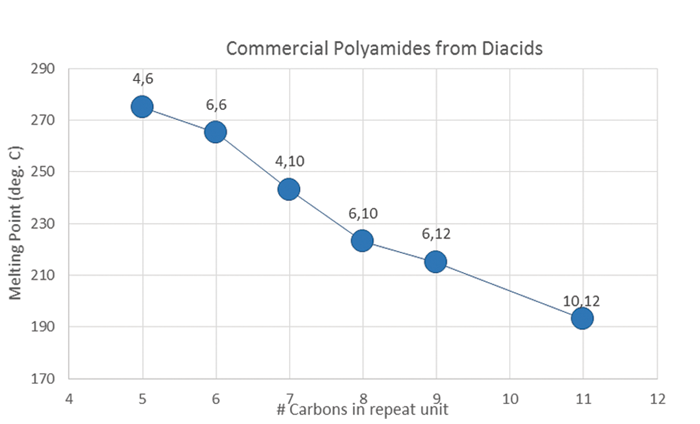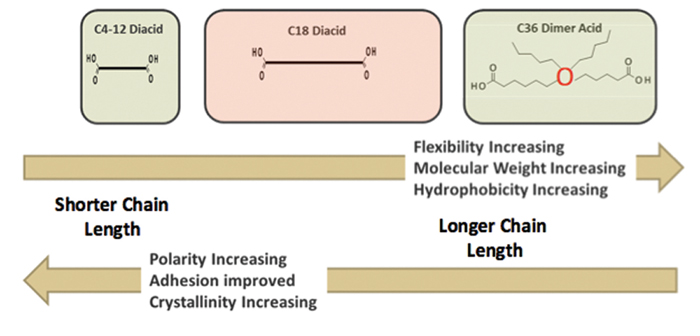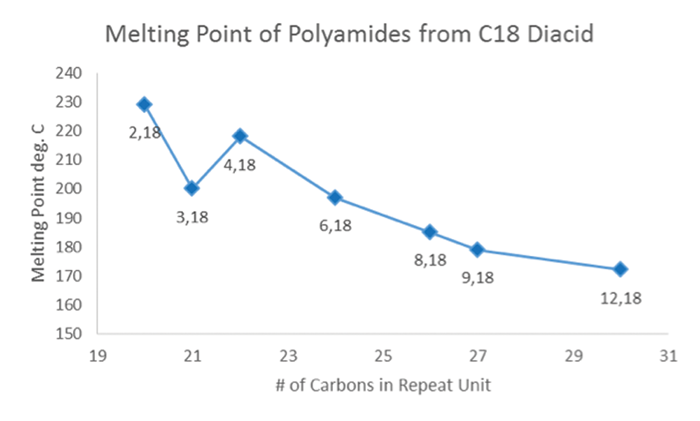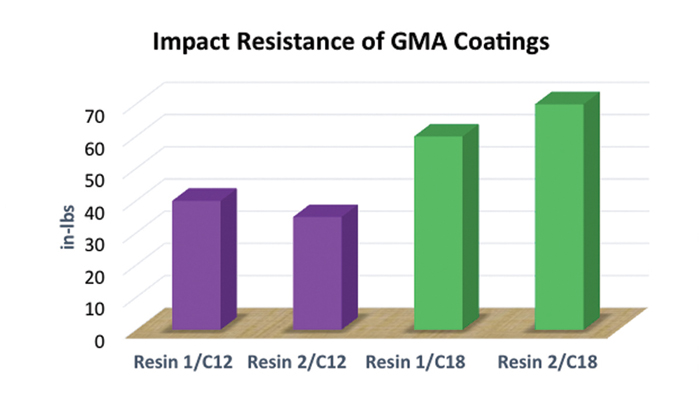A “Game-Changing” C18 Diacid for the Plastics Industry?
New technology for making diacid building-blocks creates novel polymer options
Previous Article Next Article
By Allyson Beuhler
Elevance Renewable Sciences, Inc., Woodridge, Illinois, USA
Figure 1: Commercial polyamides

Figure 1: Commercial polyamides
“High-performance polymers, used in durable goods, have had limited options for using renewable feedstocks, with castor oil being the most significant”
Figure 2: Structure-property relationships of polyamide adhesives
Figure 2: Structure-property relationships of polyamide adhesives
Figure 3: Melting points of x,18 polyamides from C18 diacid4
Figure 3: Melting points of x,18 polyamides from C18 diacid4
Figure 4: Impact resistance of GMA powder coatings (courtesy of Szuping Lu9)
Figure 4: Impact resistance of GMA powder coatings (courtesy of Szuping Lu9)
Diacids are a commercially important class of chemicals, with tens of thousands of tonnes of diacids produced annually and applications in a variety of end uses. Elevance Renewable Sciences, Inc., a high-growth specialty chemicals company, has commercialized a bio-based diacid that will significantly broaden product portfolios across a variety of industries from automotive and electronics to medical and sporting goods.
Elevance is making Inherent™ C18 diacid, also known as octadecanedioic diacid or ODDA, using a unique and efficient production process and materials produced from its world-scale biorefinery in Gresik, Indonesia. The product is the first based on the company’s proprietary metathesis technology. The process allows for the purity required for demanding applications like polymers and is a solution that is cost-competitive with other specialty diacids in the marketplace.
A mid-chain diacid, the product enables performance attributes not possible with more common, shorter-chain diacids. “Inherent C18 Diacid is the most recent addition to our growing line of bio-based commercial products that can provide our customers with high-performance solutions for their markets,” says Elevance CEO K’Lynne Johnson. “We now are advancing innovation in the plastics industry by bringing to market new linear molecules that allow our customers to improve existing polymers and create completely new polymers.”
Uses for Diacids
Diacids are particularly useful building blocks in condensation polymerization applications. The variable aliphatic chain length between the two carboxylic acid groups results in the ability to achieve an assortment of physical properties. As such, the properties of the products made can be tailored by choosing the appropriate chain length. (Aliphatic diacids are composed of two carboxylic acid functional groups linked by an aliphatic hydrocarbon spacer; the general formula for this class of compound is HO2C(CH2)nCO2H, where typically, n is between 0 and 22.)
Polyamide and polyurethane polymers from diacids are typically produced by condensation polymerization. Polyamides (PAs) range from very high melting point materials, such as PA6,6—to mid-chain length materials, such as PA6,12—to the aliphatic long-chain diacid polyamides that make up high-performance, hot-melt adhesives. Figure 1 shows some important commercial polyamides and their range of melting temperatures.
C18 diacid enables polyamides with improved moisture resistance, better optical transparency, and greater material toughness for new automotive and electronic applications. Using it with polyester polyols helps polyurethane manufacturers create polymers with exceptional solvent resistance, hydrolytic stability, optical clarity, and toughness that will benefit a variety of markets.
Polyamide hot-melt adhesives made from shorter chain lengths exhibit the best adhesion to surfaces due to the higher polarity of the molecule but, for the same reason, these adhesives are more susceptible to moisture pickup and can delaminate in high humidity environments. The less polar, longer chain lengths (C36) have lower moisture uptake, but also can have fewer amide linkages in the chain, and therefore lower overall adhesion. (This is depicted as the performance range in Figure 2.)
With the use of C18 diacid in hot-melt adhesives, this performance gap would be overcome. Specifically, using a C18 mid-range diacid to make the hot-melt polyamide should impart a combination of both higher polarity and higher adhesion due to increased amide linkages and lower moisture uptake.
Properties of Materials Made from C18 Diacid
Noteworthy products that can be made using C18 diacid include polyesterification products and polyamides. Aliphatic polyamides based on the diacid (from PA2,18 to PA12,18) have been synthesized via melt condensation.3 Note the trend in Figure 3 in the polyamide series as the spacing between amide groups increases with the longer diacids. The resulting polyamides are still highly crystalline; however, the melting point decreases as the length of the amide repeat unit increases. With higher aliphatic content, the polyamides become more resistant to moisture and organic solvents.
Interestingly, even the long-chain and highly aliphatic PA4,18 and PA6,18 polyamides exhibit very high melting points, greater than both PA10 and PA11, enabling a very high-use temperature for these C18-based polyamides.
Copolyamides of PA6,18 with other monomers have been reported in the literature. PA6,18 was co-polymerized with PA6 for use in molded and extruded thermoplastics. The resulting polyamide was reported to be more resistant to salt stress corrosion cracking and to have a lower melting point than PA6,6 and PA6,10.4
Hot-melt adhesives containing PA6,18 have been reported in the manufacture of filters. Incorporation of the long-chain diacid is reported to decrease water absorption (the Achilles’ heel of polyamides) and to provide significant increases in chemical and solvent resistance of the polyamide, including resistance to gasohol.5,6
The cycloaliphatic polyamide of bis(2-methyl-4-aminocyclohexyl)methane and C18 diacid was synthesized and shown to be a moldable amorphous polymer with lower density, increased flexibility, better chemical resistance and reduced clouding as compared to the corresponding polymer derived from dodecanedioic (C12) acid. In addition, the optical transparency was improved over dodecanedioic acid—equivalent to PMMA and superior to polycarbonate and polystyrene.7
Block copolymers of polyamides and polyethers, also known as polyetheresteramides, have been formed into shaped articles such as fibers, fabrics, films, sheets, rods, pipes, injection-molded components, or shoe soles. The polyetheresteramides that utilize C18 diacid afford a product with improved optical properties as compared to its shorter-chain homologues.8
Polyurethanes are typically synthesized via condensation polymerization of a di-isocyanate (typically MDI), a chain extender (typically butane diol), and a longer chain polyol (typically polyester or polyether). Longer-chain diacids (such as C18) can also be used to make polyester polyols that make up the soft segment in polyurethanes. The use of the longer hydrophobic chain in the polyols is expected to result in a new class of polyurethanes with a very flexible, less polar soft segment with better elasticity at low temperatures, better hydrolytic stability (due to the lower ester content), and lower moisture pick-up in high-humidity environments such as automotive.
Although a number of different resin chemistries are used for powder coatings, glycidyl methacrylate acrylic (GMA) powder coatings are known for their high gloss, durability, and abrasion resistance. They are, therefore, frequently the resin systems of choice for high-performance applications such as aluminum wheels and automotive clear coats. The C18 diacid recently has been incorporated as a crosslinker in GMA powder coatings.9
GMA resins are typically crosslinked with diacids such as dodecanedioic acid. The C12 diacid is added into the formulation, micronized into particles, sprayed and thermally cured to form a hard, glossy surface. The resulting coatings have excellent solvent resistance to common organic solvents such as MEK, good weather resistance, high gloss and excellent adhesion to metals. As a result, these materials are suitable for many high-performance outdoor applications such as automotive clear coats, coatings for aluminum wheels and outdoor furniture. A disadvantage of GMA resins is that they can be brittle due to the high crosslink density.
Inherent C18 diacid has the potential to improve flexibility and impact resistance to powder coatings due to the longer, more elastic C18 methylene chain. C18 diacid has a melting point of 124°C, compared to 128°C for C12 diacid, and therefore can be dropped into existing production lines with virtually no process changes.
Figure 4 shows a chart of the impact resistance9 of powder coatings crosslinked with C18 diacid (added in stoichiometric amounts) compared to the same resins crosslinked with C12 diacid. For both types of GMA resin formulations (1 and 2), the systems crosslinked with C18 have twice the impact resistance of systems crosslinked with C12. Furthermore, the formulations with C18 diacid, when coated on metal test panels, show high gloss, durability, solvent resistance and good adhesion to the panels. These attributes make them attractive candidates for applications requiring higher impact and flexibility than can be obtained from C12 diacid.
Condensation polymers based on C18 diacid are also expected to have much lower moisture pickup than shorter chain diacids. When C18 diacid is incorporated into polar
polymers—such as polyamides, polyesters and polyurethanes—the resulting polymers are expected to have high-temperature performance in high-humidity environments and exhibit better hydrolytic stability. This set of features is critical in under-the-hood automotive applications such as air intake manifolds, tanks for power steering fluids, coolant pumps, electronic housings, connectors and fuel lines. Other applications requiring high-humidity performance include sporting goods (e.g., roller wheels, ski boots, bicycle tires, horseshoes, and athletic shoes), power-tool housings, mobile-phone housings, gears, sprockets, automotive panels, bumpers, and airbags.
C18 Diacid Sustainability
Elevance’s products combine high performance with renewable content. The Elevance technology can use a diversity of renewable feedstocks, including palm, mustard, soybean, and, when they become commercially available, jatropha or algal oils. Each of these feedstocks can be sourced locally, enabling Elevance and its customers to reduce the carbon footprint across the entire supply chain.
High-performance polymers, used in durable goods, have had limited options for using renewable feedstocks, with castor oil being the most significant. With the C18 diacid and other products now possible using the Elevance technology, alternate renewable feedstock possibilities creating new material sourcing options and innovative performance-based solutions are available for high-performance polymer and durable goods manufacturers to expand their portfolios and supply chains and achieve sustainability goals.
Summary
The advantages of long-chain diacids, such as Inherent C18 Diacid, are numerous and varied. Incorporation of this monomer into polymers, pre-polymers, and low molecular weight compounds is expected to impart low surface tension, better dispersion and miscibility, high crystallinity, low moisture pick-up, high optical transparency, low dielectric constant, and increased hydrolytic stability over shorter-chain, more common diacids.
Note:
The original version of this article was published in the Sept./Oct. 2013 issue of bioplastics MAGAZINE (www.bioplasticsmagazine.com). Material used with permission. Also contributing to this article were Brian Albert, Paul Bertin, Steve Cohen, and Jordan Quinn.
References
- Data obtained from the Kirk-Othmer Encyclopedia of Chemical Technology, Dicarboxylic Acids, DOI: 10.1002/0471238961. 0409030110150814.a01.pub2.
- Abraham, T.; Kaido, H.; Lee, C. W.; Pederson, R. L.; Schrodi, Y.; Tupy, J. U.S. Patent Application 2009/0264672.
- Allen, Dave R. Patent Application WO2012/061094
- Bennett, C.; Matthias, L. J. Journal of Polymer Science: Part A 2005, 43, 936-945.
- Gavenois, J.; Mathew, A. K. U.S. Patent Application 2013/0052384.
- Nataniel, T.; Heinrich, D. Eur. Patent Application 1,533,330.
- Nataniel, T.; Heinrich, D. D. U.S. Patent 8,119,251.
- Bühler, F. S.; Hala, R. U.S. Patent Application 2010/0144963.
- Correspondence with Szuping Lu, Anderson Development Company.



